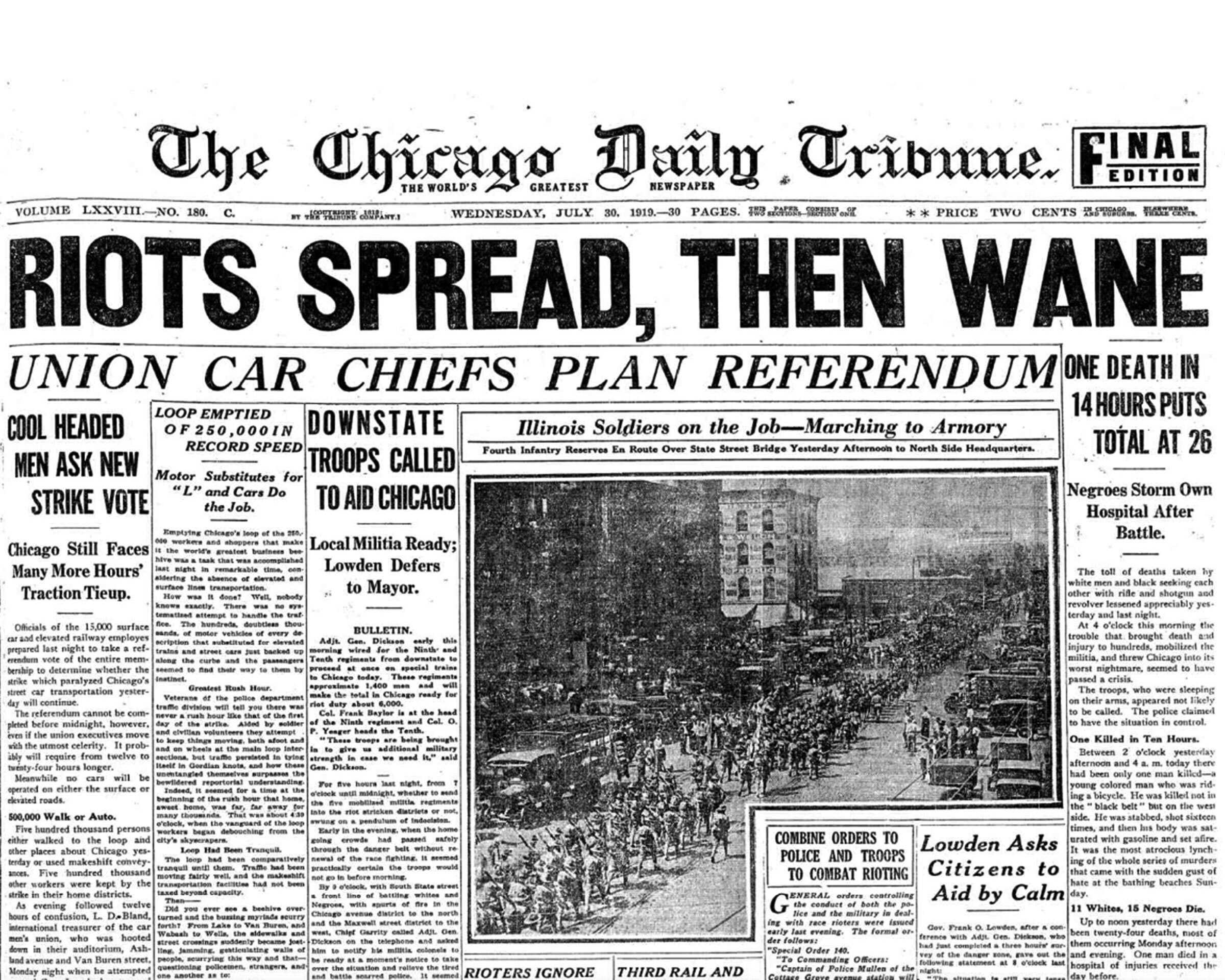Chapter 6
Navigating a Segregated Reality
Segregation did not stop African Americans from building vibrant communities. Black Americans did the same things most Americans did—they visited with friends and family, organized social functions, went to the beach, and attended church. Though segregated, the worlds they built provided a safe haven from insults, mistreatment, and violence.
During the First and Second World Wars, many African Americans developed a new cultural consciousness. After having defended democracy abroad, many returned seeking to defend their rights as American citizens and were committed to change. This new spirit was sometimes referred to as the “New Negro.” Many white Americans resented this change and fought to maintain the racial and social status quo. Mob violence and race massacres against Black communities swept the nation.
The Red Summer of 1919
Riot headline in The Chicago Daily Tribune
During the summer and fall of 1919, more than 25 cities across the country suffered outbursts of racial violence. The largest upheavals took place in Chicago, Washington, D.C., and Elaine, Arkansas. Key causes of the violence were competition for jobs and housing, as well as white resentment at African Americans’ growing assertiveness.
Many were killed and injured as African Americans, some of them soldiers, fought fiercely to protect their homes and families. Seventy-two people were lynched in 1919 alone.
Massacre in Elaine, Arkansas
Governor Charles Hillman Brough addressing a crowd after the Elaine Massacre
African-American men taken prisoner during the Elaine Massacre by U.S. Army troops
In September 1919, a mob of as many as 1,000 armed white men in Elaine, Arkansas, began killing African Americans and ransacking their homes. The massacre began in protest of Black farmers in Phillips County, Arkansas, who were organizing for higher crop prices. While some African Americans fled, others stayed, arming themselves. When U.S. Army troops arrived, they dispersed the white mob but placed several hundred African Americans in temporary stockades until their white employers could vouch for them. It is estimated that over 200 African Americans were killed, along with five white people, during the massacre.
Scipio Africanus Jones (left) with Elaine defendants
Twelve Black men taken prisoner by U.S. Army troops during the 1919 Elaine Massacre were convicted of murder by all-white juries and sentenced to death. Attorney Scipio Africanus Jones worked with the NAACP to get the convictions overturned.
Deadly Violence in Chicago, Illinois
Leaving Home
In July 1919, deadly racial violence broke out in Chicago, Illinois, after a Black teenager was pelted with rocks in Lake Michigan and drowned. Fighting soon spread throughout Chicago and lasted several days. When the bloodshed ended, 38 people—23 Black and 15 white—had been killed, and more than 500 people were injured. Hundreds of African Americans also lost their homes when they were burned by rioters. This violent episode was the most severe riot of the summer of 1919.
A Lynching in Omaha, Nebraska
Bullet holes in Omaha from the murder of Will Brown
Mob leaders attempting to kidnap Will Brown
During the summer of 1919, The Omaha Bee ran sensationalized stories of Black men attacking white women. When a local man accused a Black man of robbing him and raping his fiancée, the police arrested Will Brown, a 40-year-old African American meat-packing worker. A crowd of more than 250 people broke into the Omaha courthouse where Brown was jailed and dragged him out. Brown was shot numerous times, burned, and hanged from a lamppost. Photographs of Brown’s body reveal smiling town members in the background.
Responding to Red Summer
The violence of Red Summer sparked a new era of Black resistance. African Americans responded to the violence with public calls for self-defense, political advocacy, and racial equality. Black newspapers like the Chicago Defender raised public awareness of the violence, argued for equal rights, and asserted the right of African Americans to defend themselves.
The events of 1919 galvanized civil rights efforts in the decades that followed. Activism within organizations like the NAACP soared. African American artists and writers, including those of the Harlem Renaissance, used art and literature to explore issues of racial violence.
